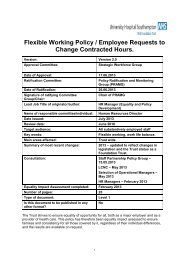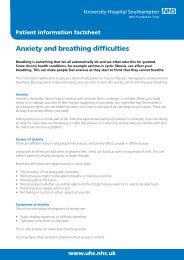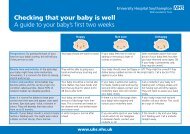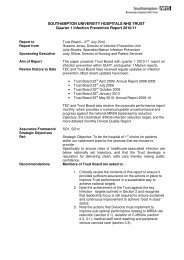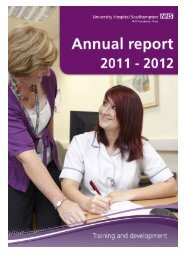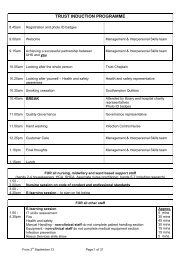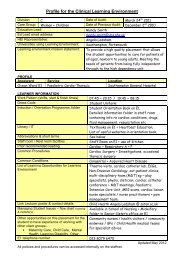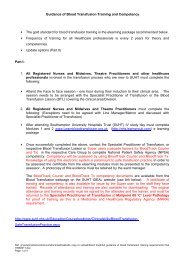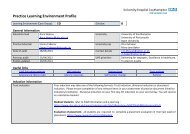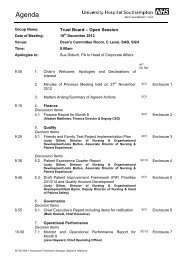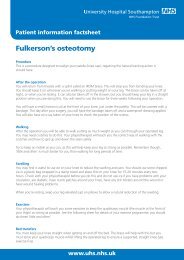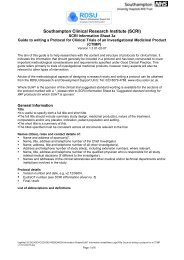ninety years of service - University Hospital Southampton NHS ...
ninety years of service - University Hospital Southampton NHS ...
ninety years of service - University Hospital Southampton NHS ...
- No tags were found...
Create successful ePaper yourself
Turn your PDF publications into a flip-book with our unique Google optimized e-Paper software.
Conclusion.I said in the beginning that these recollections would inevitably be somewhat hazy, but one looks back on those <strong>years</strong>spent at the Children’s <strong>Hospital</strong> (however ramshackle it might have appeared to the architectural eye, and howeverlimited it’s scope), a time <strong>of</strong> excellent rapport between members <strong>of</strong> staff, and with it a sense <strong>of</strong> achievement. In the childpsychiatric field a lot was owed to the foresight and dynamism <strong>of</strong> Sir John Revans whom one found easily accessible andopen to suggestions, ready to try to plan anything that led to the greater well-being <strong>of</strong> patients, Did he appreciate howeverthat “Small could be beautiful” in the sense that some <strong>of</strong> the close liaison between members <strong>of</strong> the staff would be lost in alarger hospital?CHILD PSYCHIATRY AND THE CHILDREN'S HOSPITAL 1965-1975 by Dr LeslieBartletDr Mary Copes retired in 1965 and her place was taken by Dr Leslie Bartlet. He was joined by Dr Brian Crossley in 1969,Both held parallel child guidance appointments and as a consequence there were few “boundary” problems betweenhospital and community. This resulted in fully integrated <strong>service</strong>s whichon the national scene, were quite rare then, butstandard now,As referrals increased, the need to provide treatment as well as diagnostic <strong>service</strong>s built up. When temporary out—patientaccommodation was erected at the back <strong>of</strong> the main hospital more rooms and space was allotted to the child psychiatristsSlowly the elements <strong>of</strong> a child psychiatric team came together. A psychiatric social worker from <strong>Southampton</strong> ChildGuidance clinic was seconded on a sessional basis to help, but the arrangement did not work very well and Miss JeanneChristie was appointed as Paediatric Social Worker in 1969. She agreed to work with the child psychiatrists as well as thepaediatricians and surgeons. A first rate system <strong>of</strong> teamwork developed. The team was further strengthened whets a parttimeclinical psychologist. Mr Christopher Johnson was appointed. Besides working in the team, Mr Johnson developedan assessment, advisory, and treatment <strong>service</strong> <strong>of</strong> his own and he quietly established links with the Local EducationAuthority and the local educational psychologists (a task which, at one stage, was by no means easy). Finally, in 1970, anoccupational therapist was appointed, thus rounding <strong>of</strong>f the team.The late sixties were marked by a growing interest in the needs <strong>of</strong> children with chronic illness and handicap. When DrWilliamson set up a multi-disciplinary assessment <strong>service</strong> psychiatric staff played a part in this from the start. The <strong>service</strong>turned out to be a gateway to new areas <strong>of</strong> work; in particular mental handicap and the emotional disturbances affectingfamilies with handicapped children. The enrichment <strong>of</strong> the staff with psycho-social skills knitted in well with DrWilliamson’s imaginative use <strong>of</strong> the facilities at Bursledon <strong>Hospital</strong> where the need for beds for children with chronicphysical illness was falling <strong>of</strong>f. He and his fellow paediatricians, Dr Tom Hughes-Davies and Dr John Greaves, began to“share” cases with the two child psychiatrists. Bursledon came to play an important role in the unravelling <strong>of</strong> complexproblems that <strong>of</strong>ten presented with psychosomatic symptomatology - Bursledon <strong>Hospital</strong> School under the headship <strong>of</strong>Mrs Brenda Marshall became involved. From that point on it became possible to observe and treat children from medical,social, family, emotional, behavioural and educational standpoints at the same time. Children were customarily admittedfor one to four weeks and parents were encouraged to visit daily. In the early Seventies this system, hinging on short-termadmissions, was unfashionable; indeed faintly heretical. Bowlby’s views held sway and hospitals were seen asemotionally dangerous institutions. Great care was taken to maintain close family contacts during admissions. When preschoolchildren were admitted their mothers usually came in as well. Older children had their parents visiting (or phoningregularly). No emotional damage resulted and the positive consequences were <strong>of</strong>ten significant. Particularly good resultswere obtained with such conditions as enuresis, encopresis, non-specific abdominal pains and headaches, hystericaldysfunctions. sleep disorders and behavioural disorders associated with diabetes, epilepsy and asthma.This way <strong>of</strong> working made great demands on nursing staff. Considerable reorientation was required. Nurses wereexpected to retain their traditional paediatric skills and at the same time become much more flexible, dynamically awareand emotionally involved. In the course <strong>of</strong> time “Bursledon” became an important element in the child health resources <strong>of</strong>the district. Although Bursledon <strong>Hospital</strong> was closed in 1966, the working practices developed there live on. BursiedonHouse on the General <strong>Hospital</strong> site is it’s worthy and valued successor.MEMORIESMention <strong>of</strong> the old Children’s <strong>Hospital</strong> to those with past connections with the place, whether they were patients, parentsor members <strong>of</strong> staff, always brings back old memories, mostly happy ones. These help to add flesh to the bare bones <strong>of</strong> amore factual historical record. Space permits only a fraction <strong>of</strong> these being recorded here.Ts & As in 1913.Mrs Brenda Drew recalls:- “It must have been in late 1912 or early 1913 that my sister (4 <strong>years</strong> my senior) and I had ourtonsils and, I think, adenoids removed. We had been well prepared; we would not feel anything, in fact our next-door



